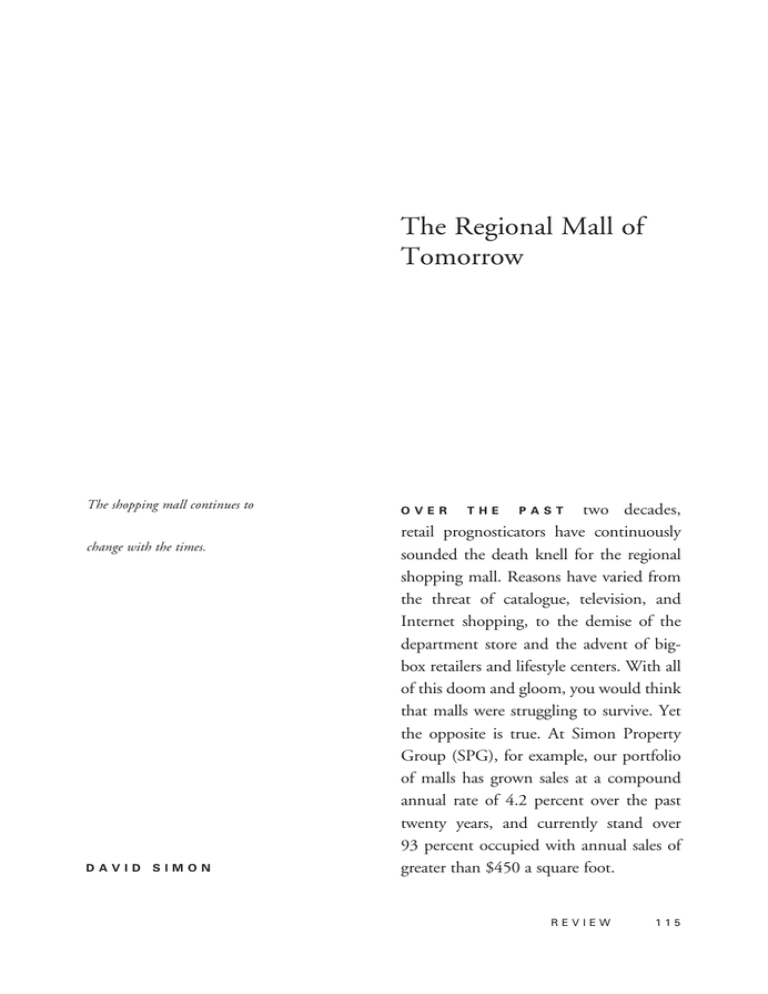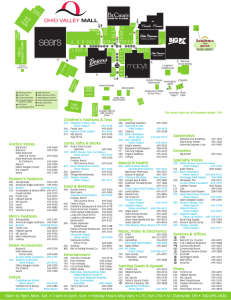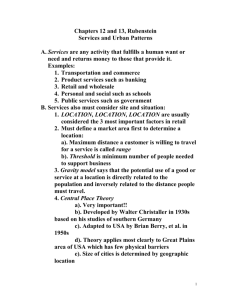The Regional Mall of Tomorrow
advertisement

The Regional Mall of Tomorrow The shopping mall continues to change with the times. DAVID SIMON OVER THE PAST two decades, retail prognosticators have continuously sounded the death knell for the regional shopping mall. Reasons have varied from the threat of catalogue, television, and Internet shopping, to the demise of the department store and the advent of bigbox retailers and lifestyle centers. With all of this doom and gloom, you would think that malls were struggling to survive. Yet the opposite is true. At Simon Property Group (SPG), for example, our portfolio of malls has grown sales at a compound annual rate of 4.2 percent over the past twenty years, and currently stand over 93 percent occupied with annual sales of greater than $450 a square foot. REVIEW 115 The reasons for the continued success of the regional mall are twofold. First and foremost, today’s successful malls have irreplaceable locations. They are located in affluent, high-density areas and are often the heart of established commercial districts. Typical trade areas extend well beyond ten to fifteen miles. Second, regional mall owners have shown an acute ability to evolve the mall and the mall’s tenant mix over time to best serve the consumer. With food courts and sit-down restaurants, movie theaters with stadium seating, and coffee shops and free Wi-Fi, the regional mall of today is much more than just a cluster of retail stores in a climate-controlled environment. The future of the regional mall will depend on this successful formula, taking advantage of the strength of the real estate, while evolving to continue to meet the demands of the consumer. STRENGTH REAL OF ESTATE Today’s regional malls occupy sites that are almost impossible to duplicate. Their superior locations were scouted out and established years ago at what were determined at that time to be the optimal regional destinations in growing metropolitan markets. And while some regional malls with weaker locations have and will 116 go out of business, centers that are well positioned will only get stronger. These centers have full commercial districts that have grown around them. Examples such as Houston’s Galleria, Lenox Square in the Buckhead section of Atlanta, King of Prussia outside of Philadelphia, and Roosevelt Field on Long Island demonstrate the advantage of strategic locations. Ironically, the current housing and capital environment will only strengthen the high franchise value and real estate position of existing regional shopping centers. The rapid suburban and exurban residential growth that typified the fifteen years prior to the housing crisis looks to be years away from reoccurring again. Meanwhile, most estimates predict that over the next twenty years, the United States will add another fifty million people to its population. During this time, established population centers and current suburban nodes—the places where regional malls already exist— will likely become even stronger. The current stock of regional malls will also benefit from the fact that almost all new retail development has come to a full stop. There are currently no new regional malls under construction or in development in the United States. Even if housing growth and the capital markets return, it will take years for new retail developments to be planned and built. As a result, expanding retailers, facing the prospects of an absence of new malls, will ZELL/LURIE REAL ESTATE CENTER continue to seek out regional malls, as they represent the best, most productive locations. Department stores, restaurants, and even non-traditional mall tenants are already adjusting their typical design and store footprints in order to take space in existing centers. For the foreseeable future, malls will be in the enviable position of being the “go to” location for retailers. Mall owners will take advantage of their real estate position while continuing to evolve their tenant mix and the shopping experience to meet the demands of the consumer. EVOLVING TENANT MIX One of the prevailing themes mentioned repeatedly when discussing the future of the shopping mall is concern over store closings and consolidations. This is noth- ing new to mall owners and is something that has been occurring for decades in both the small shop and department store world. Particularly for mall in-line tenants, turnover is a natural phenomenon occurring constantly within the retail real estate business. Concepts and brands are quick to come and go over time and the list is long when looking at small shop tenants who are now defunct. In fact, if you look at Simon’s top ten in-line tenants in 1993 when going public, they made up a much larger percentage of sales; many of the names that were at the time mainstays of the mall simply no longer exist (Table I). Certainly, turnover within the mall’s small shops will continue in the future, but as always, new retailer concepts will seek the mall for its traffic and real estate. A perfect example of this is Apple, which opened its first retail store less than ten years ago in a regional mall. Today, Apple provides a Table Ia: In-line tenants 1993 SPG’s Top Mall Inline Tenants in 1993 # of Stores Sq. Ft. (000’s) % of Total Sq. Ft. Limited 156 1,126 2.1% 5.7% F.W. Woolworth 206 642 1.2% 3.5% Melville Corp. 135 442 0.8% 2.1% United States Shoe 109 390 0.7% 2.0% Edison Brothers 110 217 0.4% 1.1% The Musicland Group 56 179 0.3% 1.1% Petrie Stores Corp. 66 346 0.6% 1.1% Zale Corp. 78 112 0.2% 1.0% Kmart (Borders) 47 173 0.3% 1.0% Payless Shoe Stores 56 177 0.3% 0.9% 7.1% 19.7% Company TOTAL % of Total Base Rent (000’s) REVIEW 117 Table Ib: In-line tenants 2010 SPG’s Top Mall/Premium Outlet Tenants at 9/30/10 # of Stores Sq.Ft. (000’s) % of Total Sq. Ft. Gap 361 3,943 1.6% 2.9% Limited Brands 335 1,890 0.8% 2.0% Abercrombie & Fitch 227 1,614 0.6% 1.6% Footlocker 388 1,516 0.6% 1.3% Luxottica Group 421 801 0.3% 1.1% Zale Corp. 349 376 0.2% 1.1% Philips-Van Heusen 223 1,212 0.5% 1.0% American Eagle 173 990 0.4% 0.9% Express 115 1,014 0.4% 0.9% Genesco 418 616 Company TOTAL unique, interactive retail experience, and has become one of the most productive and most identified tenants. A highly visible evolution has occurred in the makeup of regional malls with respect to anchor tenants. Historically, regional malls have been anchored by department stores, which have driven traffic and spurred development. Because of this important role, any weakness within the department store segment has been seen as a blow to the future prospects of the regional mall business. However, in today’s retail environment, this correlation is misguided. Malls are not as inextricably linked to the department store as they once were. When an anchor departs, mall owners are no longer dependent upon another department store to take its place. This reflects the mall’s ability to adapt along with the consumer, who over time has shown a desire to shop in many different 118 % of Total Base Rent (000’s) 0.2% 0.9% 5.6% 13.7% formats. Whether it’s another department store, the addition of “lifestyle” features, or even non-traditional mall tenants like bigboxes or grocery stores, mall owners have flexibility and options for anchoring their malls in the future. An example of this flexibility can be seen in the addition of open-air “lifestyle” wings to malls. As the consumer has shown a demand for a more “experiential” shopping trip, mall owners have responded by adding amenities such as movie theaters, large bookstores, sit-down restaurants, and open-air shopping. Not only do these additions take the place of prior department stores, in many cases they add new types of retailers to the regional mall environment, and therefore new shoppers and shopping trips. Today, the International Council of Shopping Centers (ICSC) approximates that over 20 percent of all mall anchors are not department stores. ZELL/LURIE REAL ESTATE CENTER In the future, this percentage will increase. Consumers are showing that they have many different desires when it comes to shopping, and they don’t mind combining many types of trips into one. Given the strength of their real estate, malls will continue to take advantage of this trend, adding even more non-traditional anchors to their shopping experience. The future of the regional mall will include the addition of anchor boxes other than full-line department stores. Previously, retail centers separated fullpriced stores and value-oriented shopping. Today’s consumer, however, is becoming much more accepting of an array of shopping types located in the same location. Shopping is occurring across all platforms on the same trip. Because of this, it is possible today to see high-end fashion shopping alongside big-box retailers such as Target, Dick’s Sporting Goods, or Best Buy. At South Shore Plaza in suburban Boston, SPG recently added both Nordstrom and Target, stacked on top of each other in the same wing of the center (Figure 1). The Figure 1: South Shore Plaza, Boston pairing has been accepted and embraced by both retailers and consumers. What would have appeared as strange bedfellows just a few years ago will become a much more common part of regional malls in the future. Thus, big-box retailers, once considered a threat to the regional mall, will become just another tenant. Malls are also beginning to add grocery options to their tenant line-ups. Costco, for example, recently announced its intention to enter multiple centers over the next two years. Grocers such as Wegman’s, Fresh Market, and Whole Foods are also locating in regional malls. These nontraditional anchors are taking advantage of the consumer’s willingness to shop in a more hybrid environment, and are finding the mall’s prime real estate as an attractive option in established markets where locations are scarce. THE MALL EVOLVING EXPERIENCE Advertisers and marketers have noticed the advantageous locations and the high volume of customer traffic of successful malls. This is particularly evident in the vibrancy of malls’ common areas. When originally conceived, the common areas of malls were occupied by planters, benches, and fountains. Today, you will find carts and kiosks selling specialized goods, and REVIEW 119 brands advertising their products (feet away from the point of sale). The mall’s common areas have become busy gathering places that have taken on an almost festival marketplace feel. In turn, advertisers are beginning to discover the power of advertising in this environment, reaching a large, affluent audience in a setting where their primary focus is to spend money. As print, television, and other forms of advertising continue to lose eyeballs, the mall as a marketing medium is gaining much more attention. No discussion on the regional mall’s future would be complete without a mention of e-commerce sales. The growth in this segment, though still less than 5 percent of total retail sales, is often cited as a reason for the mall’s future decline. And while shopping for specific categories of goods has been fundamentally changed by the Internet (most notably books and music), the vast majority of mall-based stores still relies heavily on shopping that is a tactile experience. Regardless of growth within their on-line segment, for most retailers it will be a complementary component to their physical locations. Retailers will always rely most heavily on their mall-based stores for displaying and selling their products. That is not to say that mall owners are sitting still. As they have always done, regional malls are evolving along with the consumer. In response to consumers’ 120 desire for using the Internet to cross-shop and find the best deals, regional malls are embracing technology. Today, almost every mall has a Facebook page. Malls are able to communicate sales and events while interacting with their customers on a daily basis. Inside the mall, owners are also communicating with their customers through smart phone applications. These apps are able to provide on-the-go access to mall maps, retailer promotions, and other mall information. They’ll even go so far as helping you find your car. At SPG, we’ve taken the smart phone app one step further by partnering with Shopkick™, a social shopping application that rewards shoppers for entering different retail stores. As the technology advances, these types of interactive platforms will become more widely available. Consumers who desire a more interactive shopping trip will have many options for enhancing their mall experience. CONCLUSION There is an old adage about real estate that says you can change everything about a property except the location. This is the ultimate strength of the regional mall— irreplaceable locations, coupled with the flexibility to evolve to meet the needs of shoppers. In the future, just as they have for the past five decades, regional ZELL/LURIE REAL ESTATE CENTER malls will continue to evolve. Mall owners will continue to improve their real estate and create shopping environments that accommodate the various shopping desires of the consumer. Not only are malls still the most sought-after and profitable means for specialty retailers to sell their goods and services, but now nontraditional mall retailers are seeking out the mall’s real estate. Mall operators have shown they have flexibility when dealing with their centers, and are adding retail amenities such as open-air shopping districts, fine dining, big boxes, and even grocery stores. Technological advances are also being made, allowing shoppers to take advantage of a more interactive shopping experience. Whatever the consumer may desire, malls have shown they will adapt to meet that demand. In that way, the mall’s past is also its future. The mall will continue to evolve, while remaining the primary shopping destination for consumers for years to come. REVIEW 121




